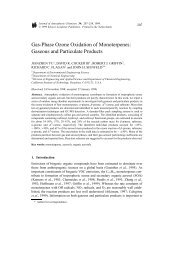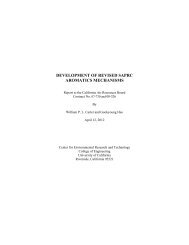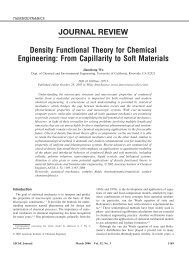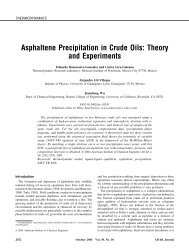State-of-the-Art Chamber Facility for Studying Atmospheric Aerosol ...
State-of-the-Art Chamber Facility for Studying Atmospheric Aerosol ...
State-of-the-Art Chamber Facility for Studying Atmospheric Aerosol ...
You also want an ePaper? Increase the reach of your titles
YUMPU automatically turns print PDFs into web optimized ePapers that Google loves.
time <strong>for</strong> diffusion to <strong>the</strong> wall <strong>of</strong> <strong>the</strong> present chamber is 1<br />
min. However, FEP Teflon film is nonabsorptive to most<br />
hydrocarbons; measured losses <strong>of</strong> C 6F 6 and m-xylene are<br />
0.001 h -1 (loss rate includes potential leaks).<br />
Acknowledgments<br />
This work was supported by <strong>the</strong> U.S. Environmental Protection<br />
Agency Center on Airborne Organics and U.S. Environmental<br />
Protection Agency Agreement CR827331-01-0.<br />
FIGURE 10. Illustration <strong>of</strong> different processes occurring within <strong>the</strong><br />
chamber. Pathways include <strong>the</strong> following: (1) condensation, (2)<br />
gas-phase wall adsorption, (3) gas-deposited particle transport, (4)<br />
particle-wall transport, and (5) coagulation.<br />
<strong>the</strong> number concentration. Because coagulation is a secondorder<br />
process, <strong>the</strong> rate <strong>of</strong> reduction in <strong>the</strong> number concentration<br />
by coagulation decreases much more rapidly than<br />
does particle loss to <strong>the</strong> walls.<br />
Table 2 gives characteristic times <strong>for</strong> chamber processes<br />
important in gas-to-particle conversion. Note that <strong>the</strong> only<br />
significant change in particle number concentration occurs<br />
through wall deposition processes (except when nucleation<br />
occurs). There<strong>for</strong>e, <strong>the</strong> number <strong>of</strong> particles in <strong>the</strong> chamber<br />
can be described by <strong>the</strong> first-order wall loss rate as N ) N oe -βt .<br />
As <strong>the</strong> mass transfer rate to suspended particles greatly<br />
exceeds that <strong>of</strong> those deposited on <strong>the</strong> wall, <strong>the</strong> amount <strong>of</strong><br />
organic material associated with each particle at <strong>the</strong> time <strong>of</strong><br />
deposition is assumed to be constant. Thus, <strong>the</strong> total organic<br />
material produced is estimated to be <strong>the</strong> sum <strong>of</strong> that still<br />
suspended in <strong>the</strong> aerosol phase plus that deposited to <strong>the</strong><br />
wall. The particle size increases due to condensation <strong>of</strong><br />
organic vapors (and any nucleation products). The final size<br />
<strong>of</strong> <strong>the</strong> particles less <strong>the</strong> initial size <strong>of</strong> <strong>the</strong> seed particles provides<br />
an estimate <strong>of</strong> <strong>the</strong> volume <strong>of</strong> organic material suspended in<br />
<strong>the</strong> chamber. Figure 10 illustrates <strong>the</strong> competing processes.<br />
Adsorption <strong>of</strong> gas-phase compounds on <strong>the</strong> wall might<br />
possibly decrease <strong>the</strong>ir concentrations since <strong>the</strong> characteristic<br />
Literature Cited<br />
(1) Carter, W. P. L.; Luo, D.; Malkina, I. L.; Pierce, J. A. Environmental<br />
chamber studies <strong>of</strong> atmospheric reactivities <strong>of</strong> volatile organic<br />
compounds. Effects <strong>of</strong> varying chamber and light source; Final<br />
report to National Renewable Energy Laboratory; 1995 (http://<br />
cert.ucr.edu/∼carter/absts.htm#explrept).<br />
(2) Liu, B. Y. H.; Lee, K. W. An aerosol generator <strong>of</strong> high stability.<br />
Am. Ind. Hyg. J. 1975, 861-865.<br />
(3) Wang, S. C.; Flagan, R. C. Scanning electrical mobility analyzer.<br />
J. <strong>Aerosol</strong> Sci. 1989, 8, 1485-1488.<br />
(4) Collins, D. R.; Flagan, R. C.; Seinfeld, J. H. Improved inversion<br />
<strong>of</strong> scanning DMA data. <strong>Aerosol</strong> Sci. Technol. 2001, In press.<br />
(5) Rader, D. J.; McMurry, P. H. Application <strong>of</strong> <strong>the</strong> tandem<br />
differential mobility analyzer to studies <strong>of</strong> droplet growth or<br />
evaporation. J. <strong>Aerosol</strong> Sci. 1986, 17, 771-787.<br />
(6) Cocker, D. R.; Clegg, S. L.; Flagan, R. C.; Seinfeld, J. H. The effect<br />
<strong>of</strong> water on gas-particle partitioning <strong>of</strong> secondary organic<br />
aerosol: I. R-pinene ozone system. Atmos. Environ. 2001, In<br />
press.<br />
(7) Cruz, C. N.; Pandis, S. N. Deliquescence and hygroscopic growth<br />
<strong>of</strong> mixed inorganic-organic atmospheric aerosol. Environ. Sci.<br />
Technol. 2000, 34, 4313-4319.<br />
(8) Nenes, A.; Pandis, S. N.; Pilinis, C. ISORROPIA: A new <strong>the</strong>rmodynamic<br />
equilibrium model <strong>for</strong> multiphase multicomponent<br />
inorganic aerosols. Aquat. Geochem. 1998, 4, 123-152.<br />
(9) Bowman, F. M.; Odum, J. R.; Seinfeld, J. H.; Pandis, S. N.<br />
Ma<strong>the</strong>matical model <strong>for</strong> gas-particle partitioning <strong>of</strong> secondary<br />
organic aerosols. Atmos. Environ. 1997, 31, 3921-3931.<br />
Received <strong>for</strong> review November 29, 2000. Revised manuscript<br />
received April 3, 2001. Accepted April 5, 2001.<br />
ES0019169<br />
VOL. 35, NO. 12, 2001 / ENVIRONMENTAL SCIENCE & TECHNOLOGY 9 2601
















